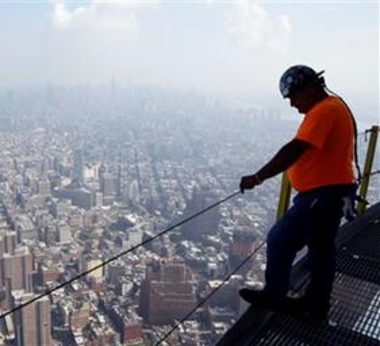US economy grew at fast 5 pct. annual rate in Q3

Washington (AP) — The U.S. economy grew at a sizzling 5 percent annual rate in the July-September period, the fastest in more than a decade, on the strength of higher consumer spending and business investment.
The resurgence in growth last quarter provided the latest evidence that the U.S. economy is steadily strengthening and outshining most others around the world. The news helped lift the Dow Jones industrial average above 18,000 for the first time, and it could affect the Federal Reserve's decision on when to raise interest rates from record lows.
In midmorning trading, the Dow was up 79 points to 18,038.
In its report Tuesday, the Commerce Department sharply revised up its estimate of third-quarter growth from a previous figure of 3.9 percent. Much of the increase came from consumer spending on health care and business spending on structures and computer software.
The economy has benefited in recent months from sharply lower energy prices, which have given consumers and businesses more money to spend on other goods and services that drive growth.
Last quarter's growth was the fastest since the summer of 2003, and it followed a 4.6 percent annual growth rate in the April-June quarter. The government separately reported Tuesday that consumer spending rose at the fastest pace in three months in November, while income posted the best gain in five months. Both were encouraging signs.
"After four years of rocky recovery the U.S. economy is now hitting its stride, with a notable acceleration in growth in recent quarters," said Gus Faucher, senior economist at PNC Financial Services Group. "And growth should remain good next year, with lower gasoline prices a big plus for consumers."
Tuesday's economic figures are sure to be closely studied by the Fed. Last week, the central bank ended a policy meeting by saying it would be "patient" in deciding when to raise rates from record lows because the economy wasn't yet fully healthy. Many investors concluded that no rate hike was likely before mid-2015 at the earliest, and they have driven stocks to record highs.
Unexpectedly strong economic growth, though, could raise pressure on the Fed to raise rates, even though inflation remains below its target rate of 2 percent.
For the current October-December quarter, most analysts think the economy is slowing to an annual rate of around 2.5 percent. And they foresee growth around 3 percent in 2015. That would still be the strongest expansion since the economy grew 3.3 percent in 2005, two years before the Great Recession began.
The 2007-2009 downturn, the worst since the 1930s, cost millions of people their jobs. Since then, the economy has struggled to regain full health. Even after the recession officially ended in June 2009, the economy has turned in tepid growth averaging 2.2 percent annually.
But many economists think growth is set to accelerate as more businesses have grown confident about hiring. The country is on track to have its healthiest year for job growth since 1999. In November, employers added 321,000 jobs, the sharpest one-month increase in three years.
With more people working and having money to spend, solid gains are expected in consumer spending, which accounts for about 70 percent of the economy.
For the third quarter, consumer spending grew at a 3.2 percent rate, the best showing this year and a full percentage point higher than the estimate the government made a month ago. That upward revision was driven by higher spending on health care.
Business investment spending rose at a 7.2 percent annual rate, 2.1 percentage points more than the government's previous estimate. Much of the new strength came from investment in structures and computer software.
The estimate released Tuesday was the government's third and final look at third-quarter growth in the gross domestic product — the value of all goods and services produced in the United States.
By Martin Crutsinger, AP Economics Writer. Copyright 2014 The Associated Press. All rights reserved. This material may not be published, broadcast, rewritten or redistributed.
The Gayly – December 23, 2014 @ 10:05am





